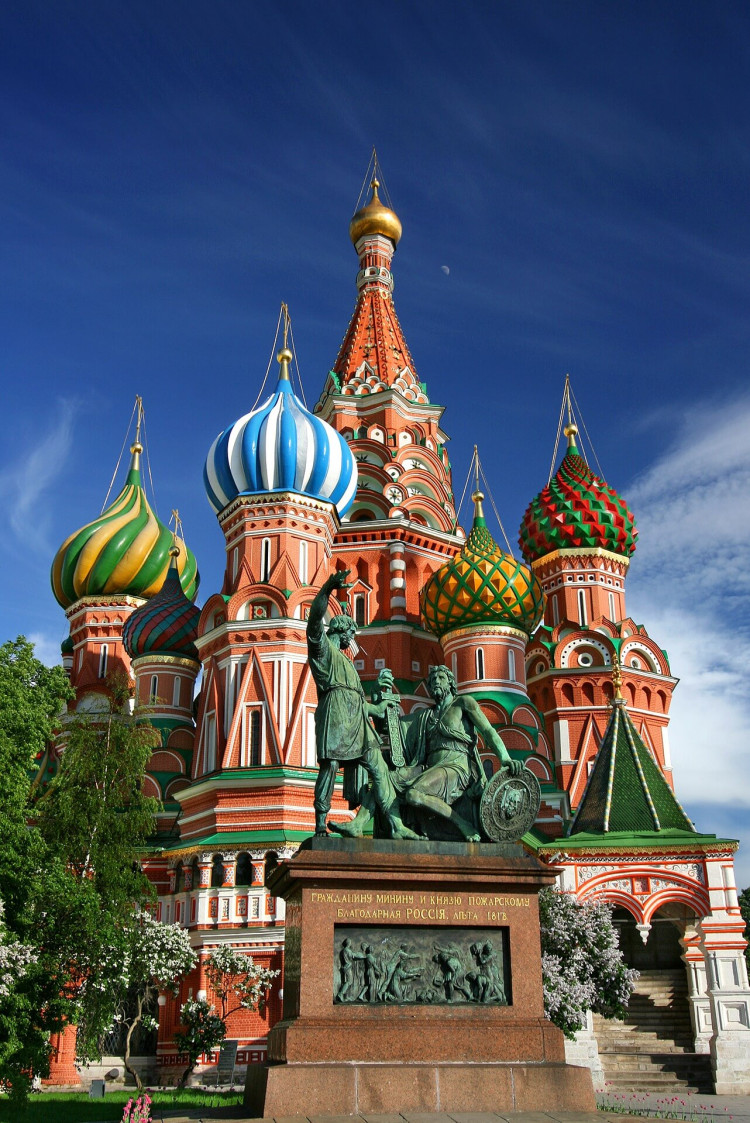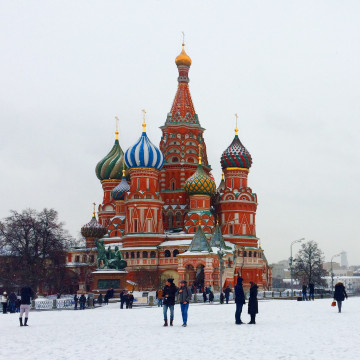Saint Basil's Cathedral in Moscow (Russia) - church in Red Square
Where is located Saint Basil's Cathedral?
Address of Saint Basil's Cathedral is 4 Krasnaya Ploshad, Moscow, Russia
show on map
When was built Saint Basil's Cathedral?
Built date of Saint Basil's Cathedral is Years 1555-1561

Facts, informations and history of Saint Basil's Cathedral
Located on Red Square, near the Kremlin, the church is a showcase of Russia, was built on the orders of Ivan IV the Terrible to celebrate victories over the Tartars.
Originally, the council consisted of eight churches with colorful domes in the shape of onions built on a common foundation. In 1588, Tsar Fiodor Ivanovich added a ninth chapel on the east side of the church above the grave of Vasilii.
It seems that the domes are arranged chaotically and there is no symmetry here, nothing more wrong. There are eight churches symbolizing eight days of fighting at Kazan, four large octagonal, four small square ones, all eight surrounding a high tower crowned with a small golden dome.
The aforementioned ninth church, added in 1588 on the eastern side, interrupts somewhat symmetry. It is easily seen from the outside by its green-gold dome studded with golden pyramids.
The interior of the church creates a labyrinth of winding passages between chapels and levels, through narrow stairs and low arches. The walls are painted in flower and geometric patterns.
The magnificent silver casket of Basilian Blessed is in the chapel of his name on the ground floor. On the upper floors in the intercession chapel is a magnificent blue-gold iconostasis (wall with icons). Other chapels, such as St. Nicholas are more restrained and even raw in their style.
In the garden in front of the cathedral stands a bronze monument commemorating Dymitr Pożarski and Kuzma Minin, who gathered the Russian army against Polish invaders during the fighting in the 16th and early 17th century.
Legend has it that after completing the construction, Ivan ordered to blind the creator of his creator, not to build a better or even similar building. Despite the eye defect, this did not prevent Postnik from taking part in the construction of the Kazan Kremlin.
In the 1770s, the domes were decorated with a colorful appearance (previously all of them were uniform, gold-plated), domes over the entrances as well as external and internal ornaments were added and paintings.
In 1929 the council closed and its bells were removed. They were re-collected in 1990. Currently, the museum has 19 bells, as well as an unusual collection of weapons from the times of Ivan the Terrible.
Since 1928, the museum has a history museum. The cathedral became a part of the Moscow Kremlin and Red Square, and in 1990 it was inscribed on the UNESCO World Heritage List.
The church is open to tourists during the week between 11-18. Not open on Tuesdays and every first Monday of the month. The cost of sightseeing is $ 3.30.
Marquis de Custine commented on colored domes as a combination of goldfish scales, enamel snake skin, variable lizard color, shiny rose and blue on pigeon neck
Architect of Saint Basil's Cathedral

How many meters have Saint Basil's Cathedral?
Height of Saint Basil's Cathedral is The height of the interiors is 64 meters
Construction/building type
Building Saint Basil's Cathedral is of type Church, Cathedral, Orthodox church
A church is a type of sacred building that acts as a place of prayer and religious practice within Christianity. The architecture of churches has evolved over the centuries, being influenced by different styles and historical periods. Below, I provide information on the precursors of church architecture, the most popular architectural styles and some well-known church buildings.... czytaj więcej.
Architectural style
Architectural style of Saint Basil's Cathedral is Russian Byzantine
What material is the building made of?
Saint Basil's Cathedral is made of the following materials: Red brick with dimensions of 28 x 14 x 8 cm
Other names
The building is also known by other common names or in the original language, i.e. Saint Basil's Cathedral, Cathedral of Basil the Blessed (ang.), Sobor Vasiliya Blazhennovo, Chram W. Błażennovo, Intercession Cathedral, Pokrovsky Sobor
Is the building on the UNESCO World Heritage List?

The listing took place in the year 1990.
Details of the entry are available on the Unesco website at https://whc.unesco.org/en/list/545/
Official website
The official website of the building, where up-to-date information can be found, is http://www.saintbasil.ru
Photo gallery Add photo
Location on map / How to get there



























Comments to Saint Basil's Cathedral (8) Average rating: 5 Add comment / Rate building
Based on 8 comments